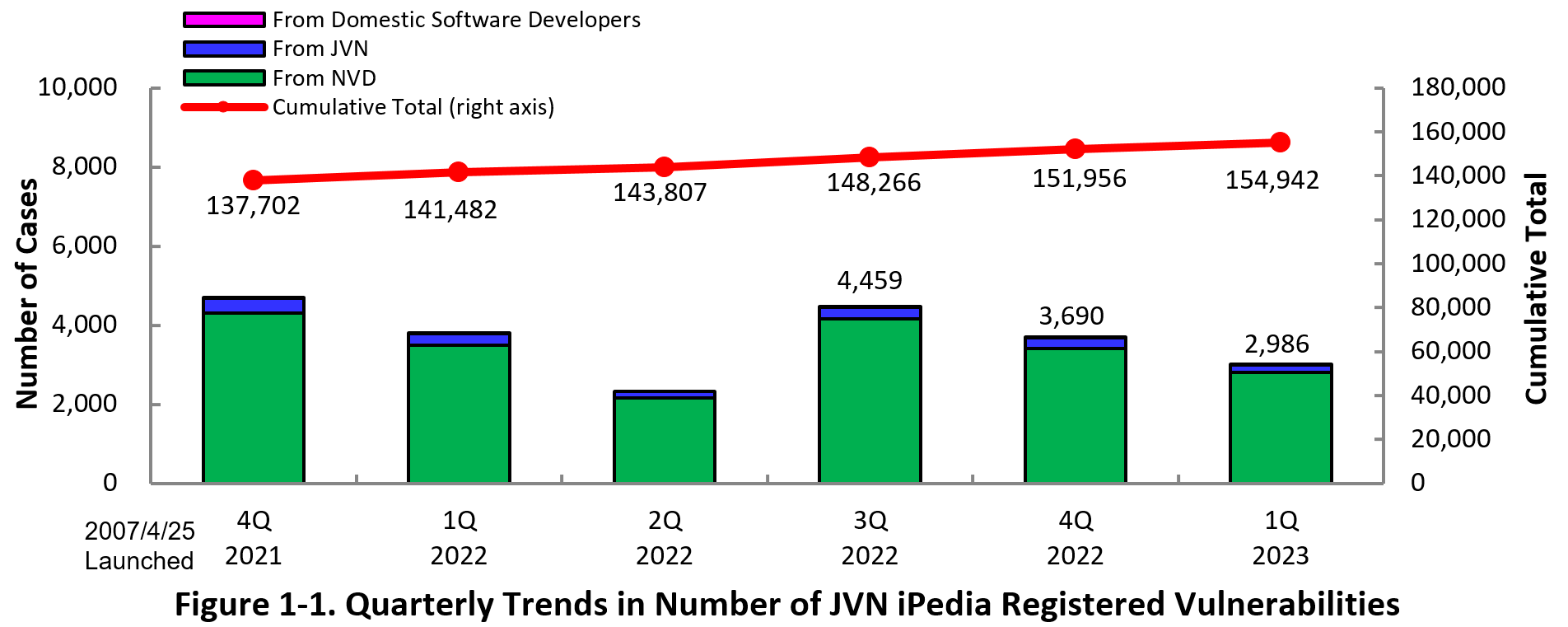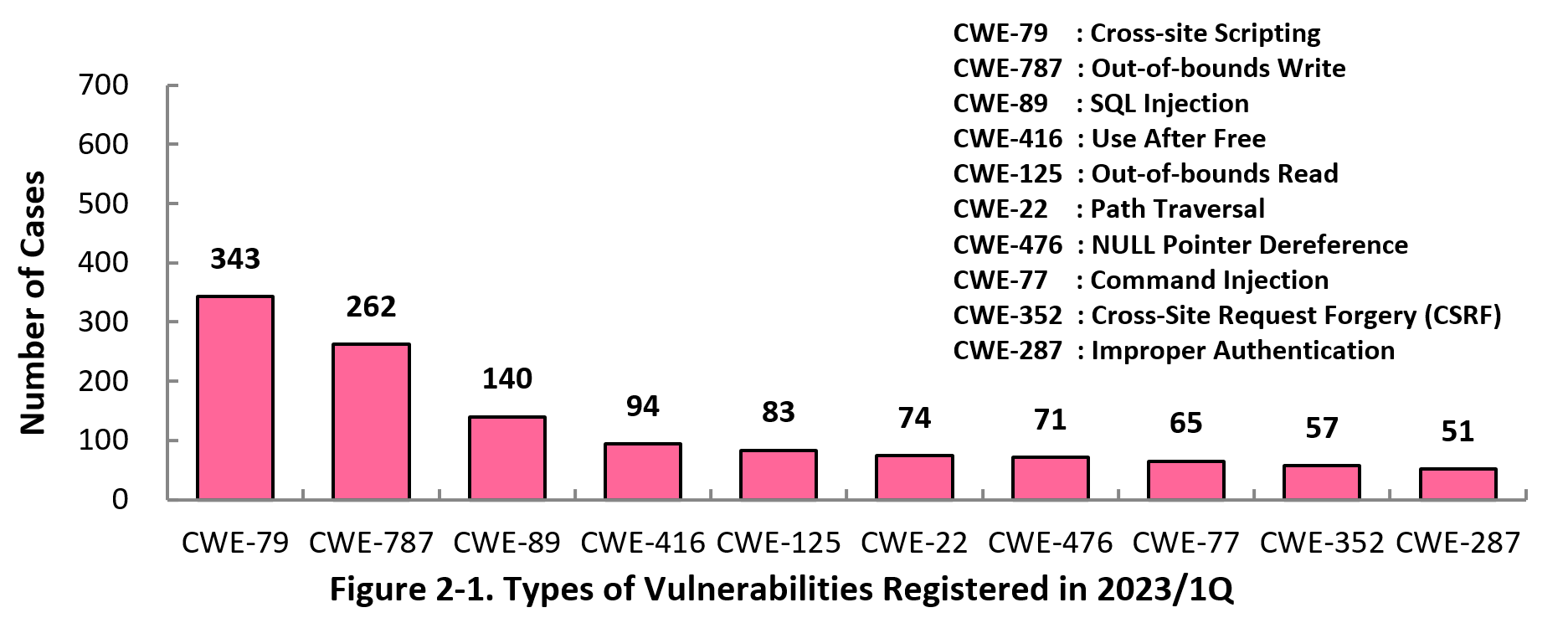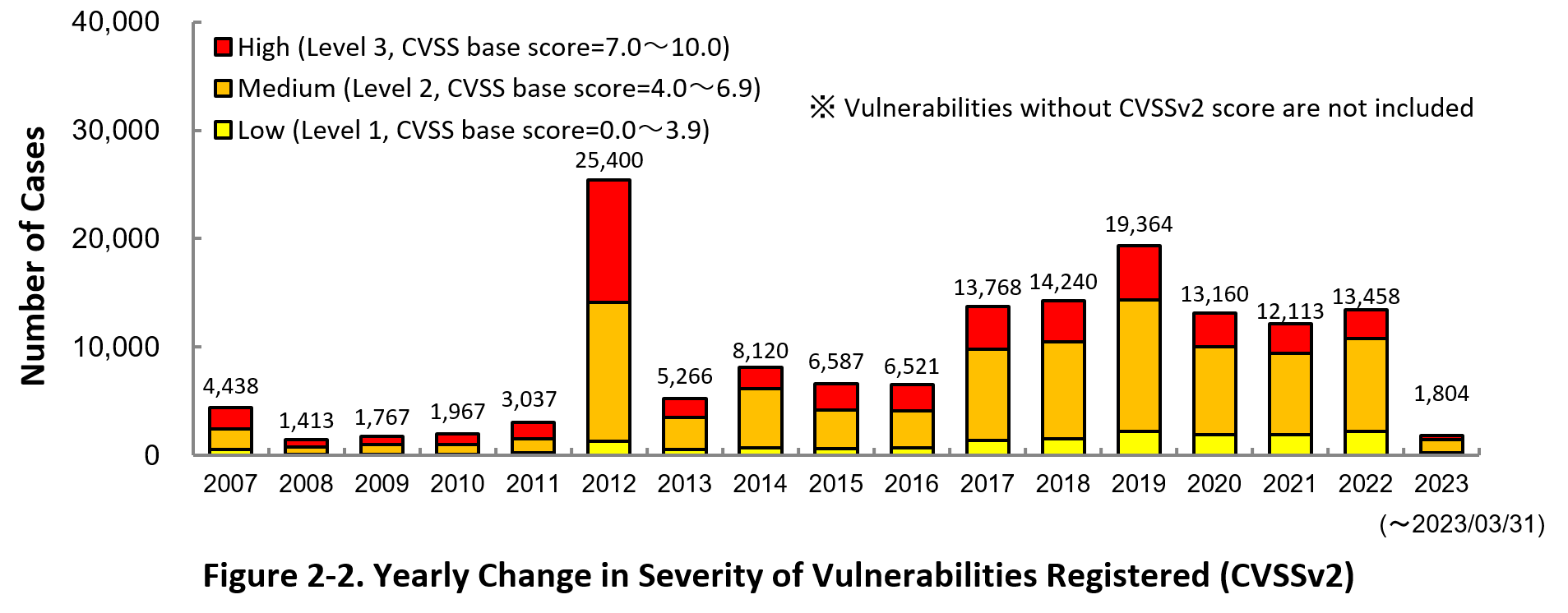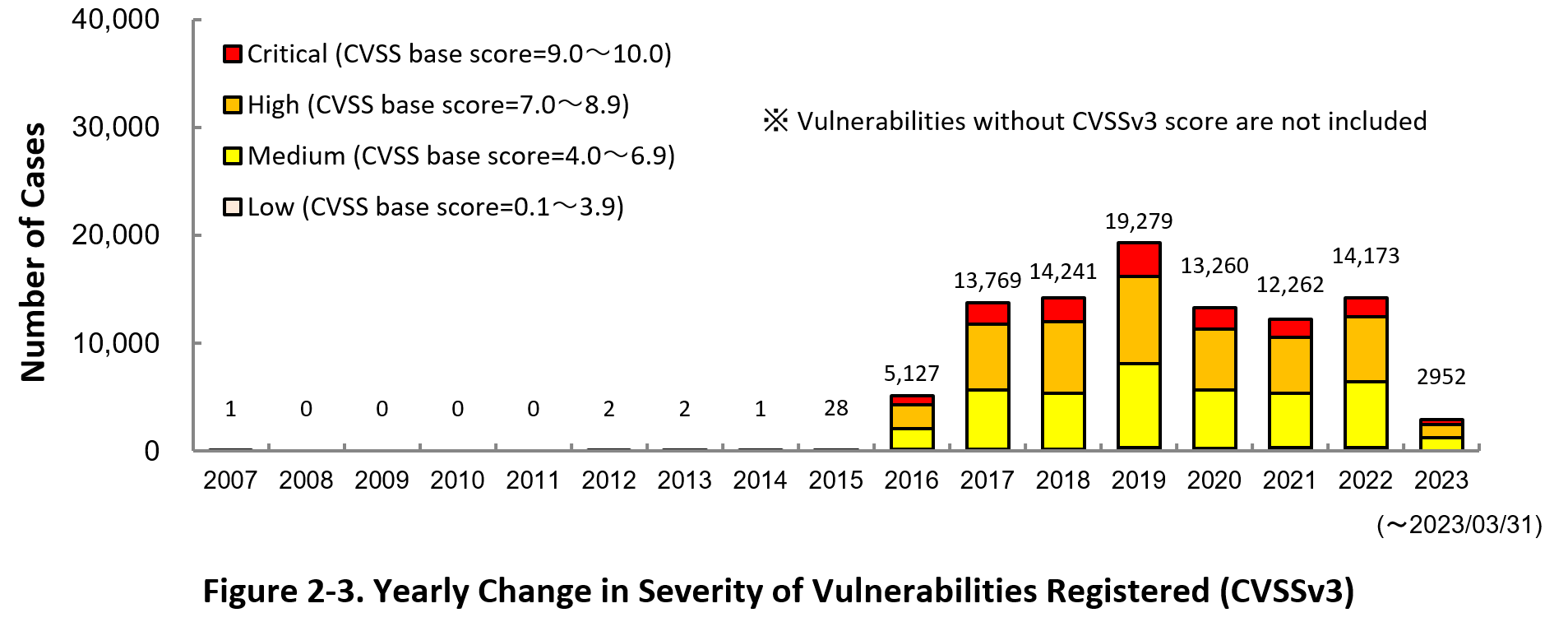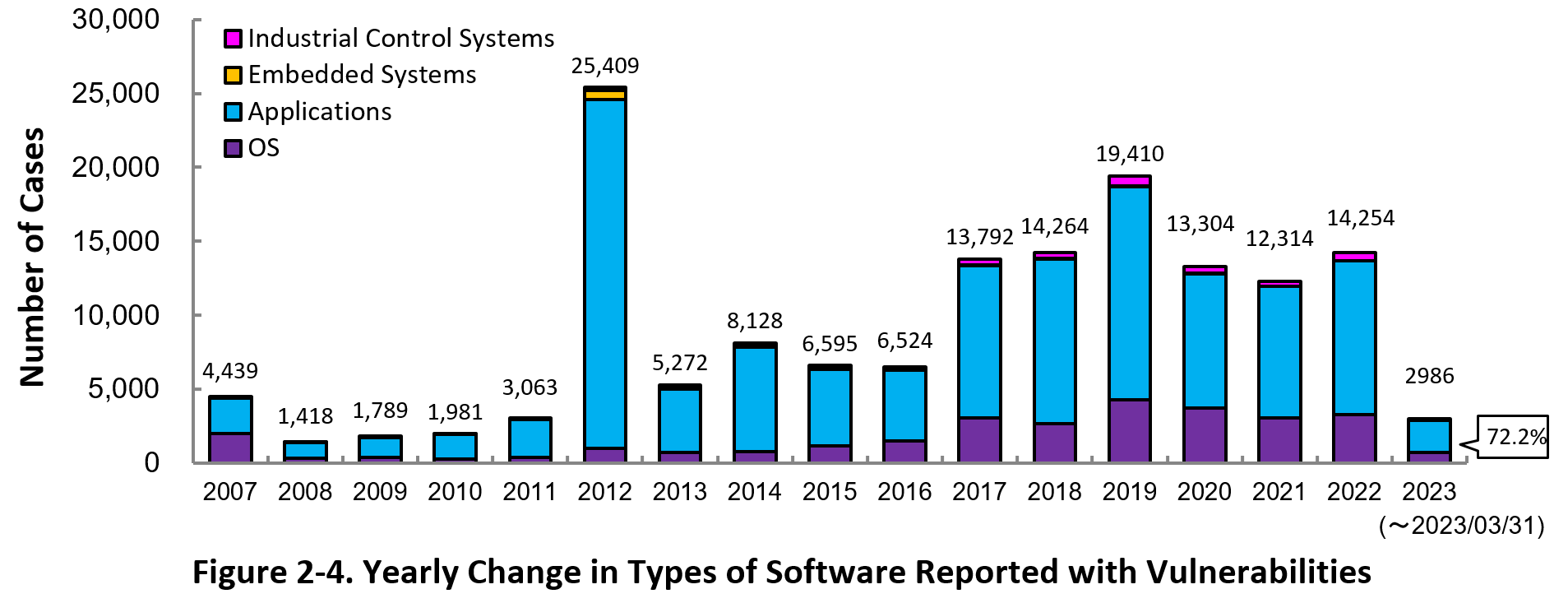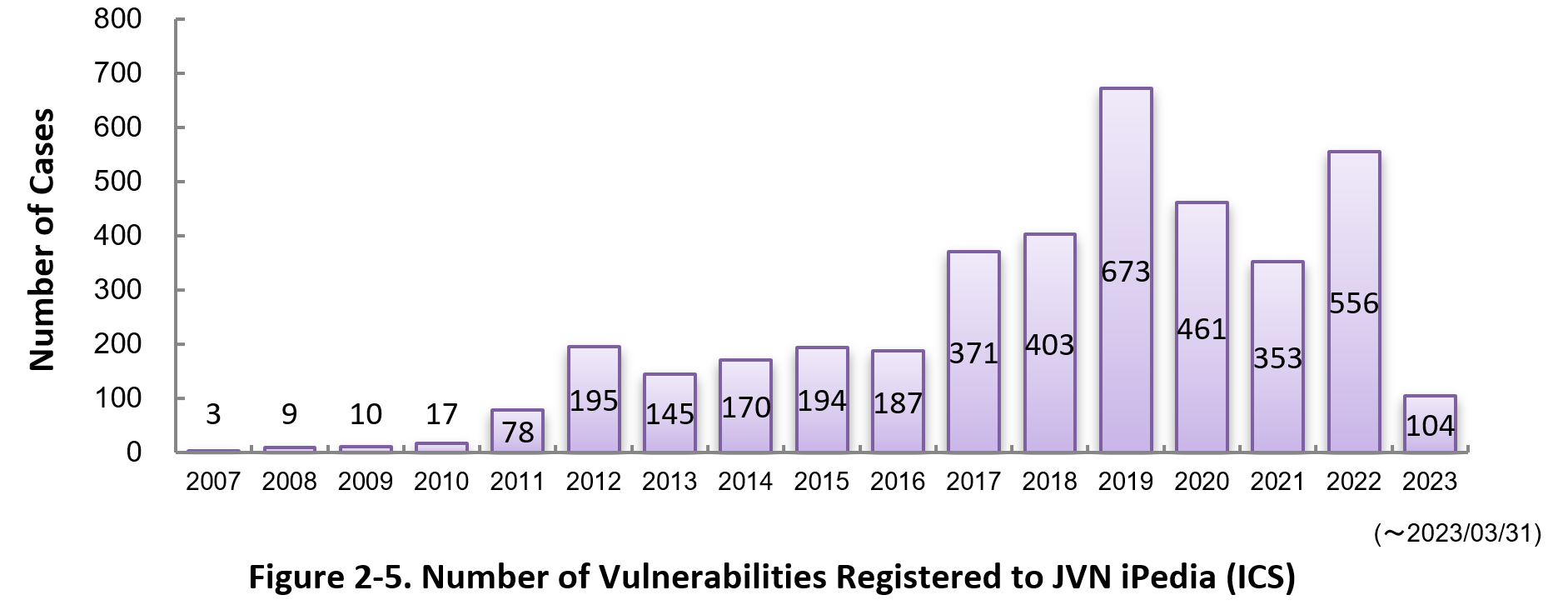Enhancing information security

Vulnerability Countermeasure Information Database JVN iPedia Registration Status [2023 1st Quarter (Jan. - Mar.)]
Release Date:May 24, 2023
IT Security Center
1. 2023 1st Quarter: Vulnerability Countermeasure Information Database JVN iPedia Registration Status
The vulnerability countermeasure information database JVN iPedia is endeavoring to become a comprehensive vulnerability database where vulnerability information is aggregated for easy access for IT users. JVN iPedia collects and/or translates the vulnerability information published by 1) domestic software developers, 2) JVN (footnote 1), a vulnerability information portal run by JPCERT/CC and IPA, and 3) NVD (footnote 2), a vulnerability database run by NIST (footnote 3). JVN iPedia has been making vulnerability information available to the public since April 25, 2007.
1-1. Vulnerabilities Registered in 2023/1Q
JVN iPedia now stores 154,942 vulnerabilities
The summary of the vulnerability information registered to the Japanese version of JVN iPedia during the 1st quarter (January 1 to March 31) of 2023 is shown in the table below. As of the end of March 2023, the total number of vulnerabilities stored in JVN iPedia is 154,942 (Table 1-1, Figure 1-1).
As for the JVN iPedia English version, the total number of vulnerabilities stored is 2,572 as shown in the lower half of the Table 1-1.
Table 1-1. Vulnerabilities Registered to JVN iPedia during 1st Quarter of 2023
|
|
Information Source
|
Registered Cases
|
Cumulative Cases
|
|---|---|---|---|
|
Japanese Version
|
Domestic Software Developers
|
2 cases
|
263 cases
|
|
JVN
|
180 cases
|
12,149 cases
|
|
|
NVD
|
2,804 cases
|
142,530 cases
|
|
|
Total
|
2,986 cases
|
154,942 cases
|
|
|
English Version
|
Domestic Software Developers
|
2 cases
|
266 cases
|
|
JVN
|
43 cases
|
2,306 cases
|
|
|
Total
|
45 cases
|
2,572 cases
|
2. Details on JVN iPedia Registered Data
2-1. Types of Vulnerabilities Reported
Figure 2-1 shows the number of vulnerabilities newly added to JVN iPedia during the 1st quarter (January to March) of 2023, sorted by the CWE vulnerability types.
The type of the vulnerabilities reported most in the 1st quarter is CWE-79 (Cross-Site Scripting) with 343 cases, followed by CWE-787 (Out-of-bounds Write) with 262, CWE-89 (SQL Injection) with 140, CWE-416 (Use After Free) with 94, CWE-125 (Out-of-bounds Read) with 83. CWE-79 (Cross-site Scripting), the most reported vulnerability type in this quarter, could allow attackers to display false webpages and/or steal information.
Software developers need to make sure to mitigate vulnerability from the planning and design phase of software development. IPA provides tools and guidelines, such as "Vulnerability Countermeasure Guide for Software Developers" (footnote 4), "How to Secure Your Website" (footnote 5), and "AppGoat" (footnote 6), a hands-on venerability learning tool, for website developers and operators to build secure websites.
2-2. Severity of Vulnerabilities Reported
Figure 2-2 shows the yearly change in the CVSSv2 rating scale based severity of vulnerabilities registered to JVN iPedia.
As for the vulnerabilities added to JVN iPedia in 2023, 20.6 percent are “Level 3” (7.0 - 10.0), 65.9 percent are “Level 2” (4.0 – 6.9) and 13.6 percent are “Level 1” (0.0 – 3.9). This means 86.5 percent of all vulnerabilities registered are Level II or higher, which are potentially critical enough to cause damage like information exposure or data falsification.
Figure 2-3 shows the yearly change in the CVSSv3 rating scale based severity of vulnerabilities registered to JVN iPedia.
As for the vulnerabilities added to JVN iPedia in 2023, 15.5 percent are “Critical” (9.0 – 10.0), 42.1 percent are “High” (7.0 – 8.9), 40.4 percent are “Medium” (4.0 – 6.9) and 1.9 percent are “Low” (0.1 – 3.9).
To avoid threats posed by the known vulnerabilities, both product developers and IT users should pay close attention to vulnerability disclosure and update software they use to a fixed version or apply a security patch as soon as possible when they become available. IT users can check vulnerabilities newly published on JVN iPedia in RSS and XML format (footnote 7) as well.
2-3. Types of Software Reported with Vulnerability
Figure 2-4 shows the yearly change in the type of software reported with vulnerability. Application vulnerabilities have been published most, accounting for 72.2 percent (2,156 out of 2,986) of the 2023 total.
Figure 2-5 shows the yearly change in the number of JVN iPedia-stored vulnerabilities in industrial control systems (ICS) used in critical infrastructure sectors. As of March 2023, the total of 3,929 ICS vulnerabilities have been registered.
2-4. Products Reported with Vulnerability
Table 2-1 lists the top 20 software whose vulnerabilities were most registered to JVN iPedia during the 1st quarter (January to March) of 2023.
In this quarter, the most registered product was Qualcomm component. After the second place, browsers and email software provided by the Mozilla Foundation and the Windows OS products provided Microsoft, were on the list.
Besides those in the top 20 list, JVN iPedia stores and offers vulnerability information about a variety of software. IPA hopes software developers and users will make good use of JVN iPedia to efficiently check vulnerability information and take necessary action in a timely manner (footnote 8).
Table 2-1. Top 20 most registered software products vulnerability countermeasure information in JVN iPedia [Jan. – Mar. 2023]
|
Rank
|
Category
|
Product Name (Vendor)
|
Number of
Vulnerabilities Registered |
|---|---|---|---|
|
1
|
Firmware
|
Qualcomm component (Qualcomm) |
382
|
|
2
|
Browser
|
Mozilla Firefox (Mozilla Foundation) |
154
|
|
3
|
OS
|
Microsoft Windows 10 (Microsoft) |
151
|
|
4
|
OS
|
Microsoft Windows 11 (Microsoft) |
150
|
|
5
|
OS
|
Microsoft Windows Server 2022 (Microsoft) |
147
|
|
6
|
OS
|
Microsoft Windows Server 2019 (Microsoft) |
141
|
|
7
|
OS
|
Microsoft Windows Server 2016 (Microsoft) |
133
|
|
8
|
OS
|
Microsoft Windows Server 2012 (Microsoft) |
126
|
|
9
|
Email software
|
Mozilla Thunderbird (Mozilla Foundation) |
116
|
|
10
|
Browser
|
Mozilla Firefox ESR (Mozilla Foundation) |
103
|
|
11
|
OS
|
Debian GNU/Linux (Debian) |
100
|
|
12
|
OS
|
Microsoft Windows Server 2008 (Microsoft) |
95
|
|
13
|
OS
|
Fedora (Fedora Project) |
83
|
|
14
|
Others
|
MicroStation (Bentley Systems) |
76
|
|
14
|
Others
|
Bentley View (Bentley Systems) |
76
|
|
16
|
OS
|
HarmonyOS (Huawei) |
67
|
|
17
|
OS
|
Android (Google) |
61
|
|
18
|
OS
|
Microsoft Windows RT 8.1 (Microsoft) |
49
|
|
18
|
OS
|
Microsoft Windows 8.1 (Microsoft) |
49
|
|
20
|
Others
|
GPAC (GPAC) |
46
|
3. Most Accessed Vulnerability Countermeasure Information
Table 3-1 lists the top 20 most accessed vulnerability countermeasure information in JVN iPedia during the 1st quarter (January to March) of 2023.
This quarter, as in the previous quarter, many vulnerabilities in WordPress and plugins for WordPress were ranked.
Table 3-1. Top 20 Most Accessed Vulnerability Countermeasure Information in JVN iPedia [Jan. – Mar. 2023]
|
Rank
|
ID/Title
|
CVSSv2
Base Score
|
CVSSv3
Base Score
|
Publication Date
|
Access Count |
|---|---|---|---|---|---|
|
1
|
JVNDB-2023-000007
|
5.0
|
7.5
|
2023/1/17
|
6,778
|
|
2
|
JVNDB-2022-000087
|
5.0
|
5.3
|
2022/11/8
|
5,547
|
|
3
|
JVNDB-2022-000091
|
5.0
|
5.3
|
2022/11/18
|
5,354
|
|
4
|
JVNDB-2022-000023
|
4.0
|
6.5
|
2022/3/30
|
5,037
|
|
5
|
JVNDB-2022-000085
|
2.6
|
6.1
|
2022/11/8
|
4,995
|
|
6
|
JVNDB-2022-000057
|
2.6
|
6.1
|
2022/7/25
|
4,975
|
|
7
|
JVNDB-2022-000038
|
2.6
|
6.1
|
2022/5/24
|
4,943
|
|
8
|
JVNDB-2022-000041
|
4.0
|
5.4
|
2022/6/1
|
4,924
|
|
9
|
JVNDB-2022-000026
|
2.6
|
4.3
|
2022/4/15
|
4,919
|
|
10
|
JVNDB-2022-000002
|
4.0
|
5.4
|
2022/1/12
|
4,916
|
|
11
|
JVNDB-2023-000001
|
6.0
|
5.5
|
2023/1/5
|
4,839
|
|
12
|
JVNDB-2023-000002
|
4.3
|
5.3
|
2023/1/6
|
4,610
|
|
13
|
JVNDB-2023-000011
|
4.9
|
6.2
|
2023/1/31
|
4,594
|
|
14
|
JVNDB-2021-000109
|
4.0
|
4.3
|
2021/12/2
|
4,384
|
|
15
|
JVNDB-2023-000013
|
4.0
|
6.5
|
2023/2/6
|
4,362
|
|
16
|
JVNDB-2023-000005
|
10.0
|
9.8
|
2023/1/11
|
4,327
|
|
17
|
JVNDB-2023-000004
|
4.3
|
4.7
|
2023/1/11
|
4,265
|
|
18
|
JVNDB-2023-001220
|
-
|
-
|
2023/2/22
|
4,227
|
|
19
|
JVNDB-2021-000104
|
2.6
|
4.3
|
2021/11/25
|
4,208
|
|
20
|
JVNDB-2021-000103
|
2.6
|
4.3
|
2021/11/16
|
4,189
|
Table 3-2 lists the top 5 most accessed vulnerability information among those reported by domestic software developers.
Table 3-2. Top 5 Most Accessed Vulnerabilities Reported by Domestic Product Developers [Jan. - Mar. 2023]
|
Rank
|
ID/Title
|
CVSSv2
Base Score
|
CVSSv3
Base Score
|
Publication Date
|
Access Count |
|---|---|---|---|---|---|
|
1
|
JVNDB-2023-001008
|
-
|
6.6
|
2023/1/18
|
3,547
|
|
2
|
JVNDB-2022-002771
|
-
|
3.3
|
2022/12/7
|
2,688
|
|
3
|
-
|
5.4
|
2022/10/5
|
2,490
|
|
|
4
|
-
|
-
|
2022/9/14
|
2,487
|
|
|
5
|
-
|
-
|
2022/8/1
|
2,455
|
Footnotes
(1) Japan Vulnerability Notes: A portal for vulnerability countermeasure information including information on vendor response to the reported vulnerabilities and security support. Operated in the collaboration of IPA and JPCERT/CC.
(2) National Vulnerability Database: A vulnerability database operated by NIST.
(3) National Institute of Standards and Technology: A U.S federal agency that develops and promotes measurement, standards and technology.
(4) Vulnerability Countermeasure Guide for Software Developers (in Japanese only)
(5) How to Secure Your Websites (latest version in Japanese only)
(6) AppGoat (in Japanese only)
(7) IPA Data Feeds (in Japanese only)
(8) IPA Technical Watch - Daily Practice Guide (in Japanese only): Tips on Vulnerability Management The guide gives tips on how to efficiently and efficiently collect and leverage vulnerability information.
Past Quarterly Reports
Contact information
IT Security Center,
Information-technology Promotion Agency, Japan (ISEC/IPA)

